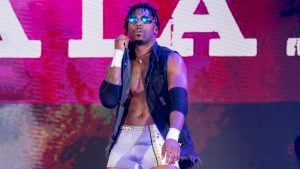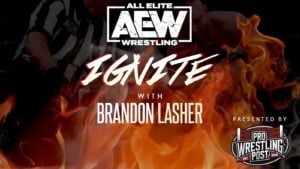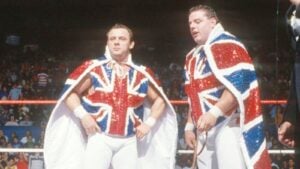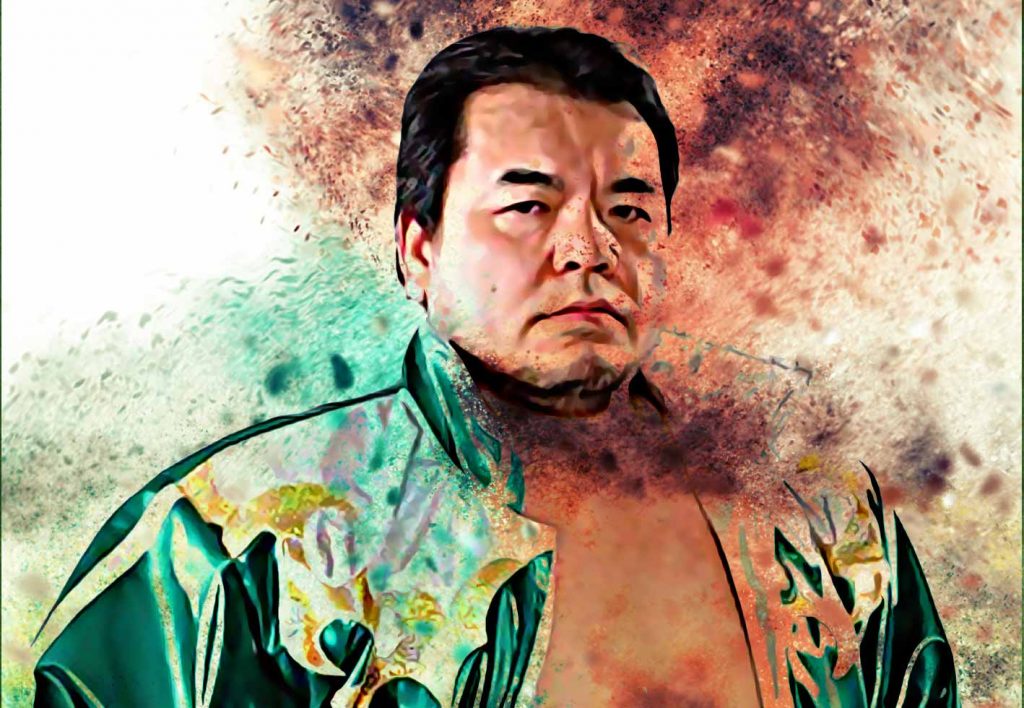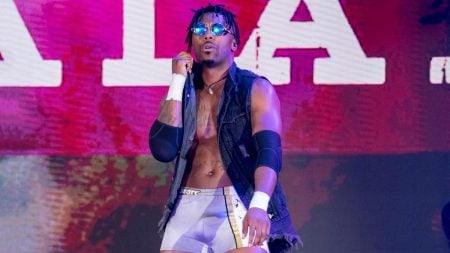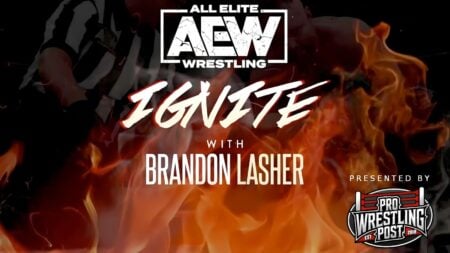“The Ace of All Japan Pro-Wrestling.” “Greatest pro wrestler ever.” “The Standard Bearer for Future Generations.” These are a few terms used to describe one of the most famous wrestlers in Japanese wrestling history. He’s a man so revered and admired that CM Punk got a tattoo of the man’s wrestling boots. This is Mitsuharu Misawa.
______________
In fact, the work this wrestler and his compatriots did in the 1990s had a direct impact on the wrestling style of the early 2000s independent wrestling scene. That same scene that spawned the likes of Punk, A.J. Styles, Daniel Bryan, Chris Hero, Daniel Bryan, Samoa Joe, and many others. His name is Mitsuharu Misawa, and today we’ll take a look at what made him into a true legend in pro wrestling.
Mitsuharu Misawa – Early years
Like many wrestlers, Mitsuharu Misawa was a wrestling fan growing up and knew he wanted to become one when he was a child. He started amateur wrestling in high school and became so good at it that he became a national champion.
But for him, amateur wrestling was only a means for him to break into pro wrestling, which was encouraged to him by then-AJPW star Jumbo Tsuruta. It was also during this period that Mitsuharu Misawa first met Toshiaki Kawada, with whom his in-ring career would later become inextricably linked.
Mitsuharu Misawa wrestled mainly undercard matches from his debut in 1981 to early 1984, before being sent on a foreign excursion to Mexico. While in Mexico, Mitsuharu Misawa began to improve upon his aerial skills thanks to help from some of Mexico’s finest luchadores. But that excursion was cut short because AJPW owner Giant Baba bought the rights to the Tiger Mask gimmick from New Japan and needed someone that could ‘jump from the corner post.’
MitsuharuMisawa spent the following five-and-a-half years wrestling as Tiger Mask II. He grew into an even bigger star during this period and wrestled with many high-profile stars. His opponents around this time included: Kuniaki Kobasashi (with whom Misawa would have his first of twenty-five five-star matches), ‘Mr. Perfect’ Curt Hennig, Ricky Steamboat, Ted DiBiase, Bret Hart, and Ric Flair.
A chance occurrence for Mitsuharu Misawa
In early 1990, AJPW suffered a critical loss of talent. Genirhiro Tenryu, one of the biggest AJPW stars of the prior decade, left AJPW abruptly and took many wrestlers with him. He had disagreed with Baba over AJPW’s creative direction and had been lured away by the owner of a glasses company with the promise of big money.
AJPW was gutted of talent, which forced Baba to completely rethink his booking strategy. Thus, he decided to take the mask off Misawa and turn him into the ace of the future.
Unmasking and first rivalry
To make Misawa into a believable star, Baba made a few genius decisions. First, Misawa ordered then-partner Kawada to untie his mask. Once the mask came off, Misawa attacked Tsuruta (who was Misawa’s childhood idol) to set up a rivalry between them. Then came their first major singles encounter. For weeks leading up to that match (scheduled for June 8th, 1990), Baba hadn’t decided on who’d win: Tsuruta or Misawa.
So Baba spent many days of the tour sitting next to the AJPW merchandise stands. And as the shows would end, throngs of fans would charge the merchandise tables and buy all the Misawa merchandise. This went on for weeks, especially as fans in attendance would chant Misawa’s name all night long.
So Baba made an uncharacteristic decision: on the eve of the big singles match, he reversed his original plan for Tsuruta to win and decided that Misawa would instead. Tsuruta was initially shocked and wanted a double-count-out finish instead, to which Baba replied, ‘No’.
And so it went. Misawa defeated Tsuruta decisively, without shenanigans, controversy, or grandstanding from Tsuruta. He scored a huge victory, and from then on was considered the future of AJPW.
From June 1990 until the end of 1992, Misawa and Tsuruta were embroiled in a bitter feud. It eventually expanded to include two entire stables of wrestlers. On one side was Tsuruta and his group of veterans (plus Akira Taue). And on the other side was Misawa and his Super Generation Army (which included the likes of erstwhile partner Kawada and then-rookie Kenta Kobashi).
This feud gradually grew more intense, especially with the inclusion of gaijin/foreign wrestlers as well. Not only did MitsuharuMisawa have to deal with Tsuruta and his gang, but he also faced threats like Stan Hansen, Terry Gordy, and ‘Dr. Death’ Steve Williams. During these early years, Misawa lost to these foreign menaces more often than he won, especially against Hansen. But AJPW fans were invested in Misawa so much that they just wanted to see him wrestle, regardless of whether he won or lost.
This was proven on March 4th, 1992, with Stan Hansen defending the Triple Crown Heavyweight Championship against Misawa. That show set a new record for Bukodan Hall at 16,300. This was critical because Budokan Hall was considered AJPW’s home base, similar to how WWE considered Madison Square Garden theirs. This sellout was the first of countless that would follow for each AJPW tour until 1996.
The Tsuruta-Misawa feud ended in late 1992 after Tsuruta was diagnosed with Hepatitis. Unable to wrestle at a main-event level any longer, Misawa needed a new main rival to carry the brand going forward. And once again, Baba devised a genius booking strategy to answer this challenge. Baba turned Toshiaki Kawada from Misawa’s main partner into his archrival.
In doing so, Baba capitalized on the very real relationship that Misawa and Kawada had. They had met in high school, and it was Misawa that convinced Kawada to join AJPW instead of rival New Japan. But while they trained together, their foreign excursions were polar opposites.
Misawa succeeded in Mexico, while Kawada languished in Canada. And upon hearing of Misawa’s success as Tiger Mask and of the opportunities he was getting, Kawada was said to grow bitter and jealous.
Thus, Kawada betrayed Misawa and joined formal bitter rival Akira Taue and formed The Holy Demon Army. Meanwhile, Kenta Kobashi was elevated to being Misawa’s main tag team partner against Kawada and Taue.
This quartet would soon become known as ‘Shitennou’, better known as The Four Pillars of Heaven. Together, they would put on some of the greatest matches of all time.
The Four Pillars and All Japan’s Golden Age
Misawa won the Triple Crown Heavyweight Championship for the first time on August 22nd, 1992, by beating Stan Hansen. From then until 2000, Misawa was the unquestioned ace of AJPW.
On many occasions, he held more than one title at once, defending both his singles title and tag titles against a wide variety of opponents. He also took part in AJPW’s annual singles tournament (The Champion Carnival) and their December tag team tournament (The World’s Strongest Tag Determination League).
From 1992 to 1999, Misawa would have spectacular, godlike singles and tag team matches on a regular basis. These matches sold-out events all across Japan and became hot commodities in the tape trading community in North America. Whether in singles matches or in tag team matches, Misawa put on one wrestling classic after another. He was lauded for his wrestling skill and for being the biggest beneficiary of King’s Road-style wrestling.
The King’s Road style
The ‘King’s Road’ is unique to 1990s All Japan and the early years of Pro Wrestling NOAH. It’s a style that combined Japanese puroresu – with its martial arts origins and emphasis on natural toughness – with NWA-style brawling and match structure.
These matches tend to have three distinct acts. The first is an opening sprint in which two wrestlers jockey for control using real amateur grappling and stiff strikes. The second is a ‘working’ phase in which submission holds are used to wear down body parts – usually with submission holds – and to make it harder for either man to execute their biggest moves. The final act is a finishing spree in which both sides execute as many big moves as they can, layering them on top of each other to make the subsequent one more likely to end the match.
Although this structure might translate into formulaic and repetitive matches, the results couldn’t be further from the truth, No two King’s Road matches were/are the same, even if similar elements exist in all of them.
This is because King’s Road’s second element is long-term, nuanced stories. Rivalries are extended over years, with key matches happening at different spots along the way. The stories evolve based on what happens in the ring, and the decisions of those matches lead to more exciting stories in the future.
In Misawa’s case, he was involved in multiple stories told over the course of an entire decade. For the first two years of the 1990s, he was both embroiled in a war with Tsuruta while also trying to establish himself as a singles star. Both those stories ended in 1992, only for new ones to unfold.
In 1993, Toshiaki Kawada became his archrival, and the two of them fought in many singles and tag classics, including a few that took place while they were still partners. Kawada wouldn’t pin Misawa cleanly until 1995, five years after they had their first major match together. And that win was in tag team competition. Kawada wouldn’t score a decisive win over Misawa until 1998.

Misawa also had to deal with other overlapping stories: Kobashi going from his partner to a secondary rival; struggling with ‘Dr. Death’ and his devastating Dangerous Backdrop that beat everyone, Jun Akiyama being elevated from partner to opponent, the list goes on. These overlapping stories and rivalries translated into deep, intricate matches in which every move meant something.
These unpredictable contests were heralded as part of the true golden age of puroresu, and Misawa was arguably the defining fixture of that period. During his peak as a performer, Misawa wasn’t just a massive draw for AJPW. He was a critically-lauded performer as well, receiving praise from publications all over the world. Both Tokyo Sports and Nikkan Sports, two of Japan’s top and most prestigious sports publications, heaped praise on Misawa and his matches throughout the decade.
In North America, Misawa was showered with praise by the Wrestling Observer and its fans. Aside from numerous distinctions as wrestler of the year (in both singles and tags), Misawa holds the record for most five-star matches out of any wrestler ever. As of June 2020, Misawa has been in twenty-five 5-star matches and was in the first-ever official 6-star match as well.
Of course, the other, unofficial rule of King’s Road matches was to have increasing layers of danger to them. If a move felled an opponent early on, it would fail to keep them down, later on, requiring a wrestler to land a bigger (read: riskier) move in the future.
Thus, by 1998, King’s Road transformed into ‘the head spike era’, in which high-risk moves became the norm. Although all of AJPW’s biggest stars delivered and took these moves, Misawa is believed to have taken more of them than anyone. This helped build up his aura of being indestructible since he’d take such inhuman punishment and still find a way to win.
But it wasn’t just his actions that got him praise; even his inaction got him positive attention from Japanese fans.
Mitsuharu Misawa – A symbol of Japanese culture
Many people, especially in the English-speaking world, still wonder why Misawa was so beloved by his native fans. After all, many people noted that other AJPW wrestlers, especially Kawada and Kobashi, were more dynamic and exciting as wrestlers. Why? Because they showed more emotion in their matches.
One needn’t look far to see Kobashi stare daggers at his opponents or hear Kawada snarl at his opponents as he dropped them with a kick. These displays of emotion were what made those two wrestlers stand out as Japanese wrestlers.
But Misawa? He always had the same expression on his face. Getting kicked in the face? Mildly annoyed. His partner is getting demolished by cheating opponents? Mildly annoyed. Making a babyface comeback? Blank expression. His opponent refuses to stay down?
Again, mildly annoyed. Misawa almost always had the same stone-faced expression upon his face, even in post-match victory celebration. In fact, it was extremely rare to ever so much as see him smile, much less laugh or otherwise show any humanity.
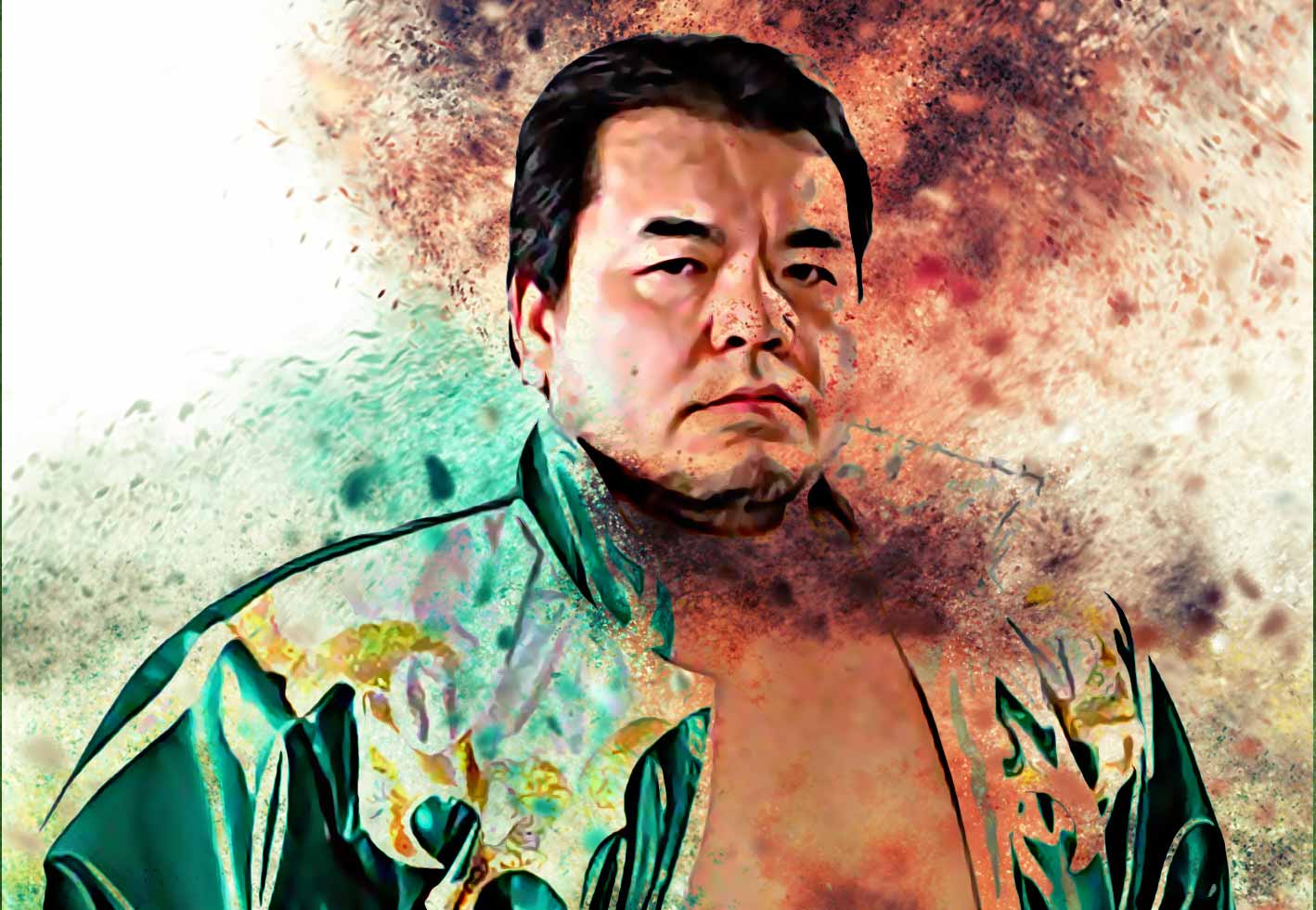
But that’s why the Japanese fans loved him. East Asian cultures are, on average, less expressive and emotional than their American and western counterparts. The Japanese keep their emotions under control because to release them is considered a betrayal of self-control.
Using Misawa’s two biggest rivals – Kawada and Kobashi – as examples, we can see how fans reacted differently to them. When Kobashi would ‘fire up’ or get angry, the fans would react, true enough. And when Kawada unleashed a massive kick and his inhuman grunts echoed throughout the arena, the fans would appreciate that as well.
But Misawa always got bigger reactions while remaining forever stoic. In doing so, he showed he was always in control, he was always collected, and he was always focused and not being guided by his emotions into making rash decisions.
Giant Baba’s Death
AJPW took a massive hit in 1999 when Giant Baba died. Not only was he one of the most beloved wrestling figures in Japan, but he was also admired by his wrestlers. He was respected as a booker and promoter, and having a handshake deal with Baba was as valuable as a signed contract because he never broke his word. And when he died, it turned AJPW’s boardroom into a warzone.
That war featured two diametrically-opposed sides in Misawa and Baba’s widow Motoko. These two highly-influential people disagreed on many things surrounding AJPW. Misawa wanted to modernize the product, push younger talent (including junior heavyweights, who had long languished in AJPW.
Unlike in NJPW, where they thrived) and wanted to restructure the company to pay the wrestlers better. He especially wanted to end AJPW’s isolationism, given NJPW had made a fortune with such programs for many years and run bigger venues like the Tokyo Dome more often.
Motoko, on the other hand, firmly believed that AJPW, and puroresu in Japan in general, had peaked. Thus, she wanted to keep things unchanged and wanted to continue her late husband’s booking philosophy into the new millennium.
Eventually, Misawa became so fed up with Motoko overruling him (despite Misawa being AJPW president at the time), that he decided to form his own company. After over a year of intense talks, in June 2000, Misawa announced that he and 95% of the AJPW roster were leaving to form Pro Wrestling NOAH. Of the native wrestlers, only two didn’t follow him: lower-card veteran Masanobu Fuchi and Toshiaki Kawada.
NOAH’s early years
Despite the significant press during its opening months, NOAH struggled at first. Motoko had been proven right to an extent as the entire wrestling industry was down between 2000 and 2002. Mixed Martial Arts was making waves in Japan, and puroresu was largely viewed as ‘the dated, fake version.’
Worse, the company really didn’t have someone to carry the company. Although the company was his, Misawa was reluctant to be the ace that wrestled in the biggest matches. He had many injuries from wrestling, some dating as far back as 1985. He had already injured his knees and legs many times as Tiger Mask II, and the punishing King’s Road style of the 1990s had taken their toll on his body, especially his neck.
Misawa’s initial plan was to have Kobashi carry NOAH until a suitable successor could be found. But Kobashi spent most of 2001 and 2002 out with multiple knee injuries. In fact, Kobashi’s originally-scheduled 2002 return was delayed by six months because his knees blew out in his return match.
So during this period, Misawa reluctantly carried NOAH on his (badly-damaged) shoulders, wrestling against top local stars like Jun Akiyama and outsiders like Yoshihiro Takayama and Shinya Hashimoto.
Then, on March 1st, 2003, Misawa would have the last great match of his career (and indeed, his life). He wrestled Kenta Kobashi for the GHC Heavyweight Championship and lost it to him in a 35-minute epic that’s widely regarded as one of the best matches of all time. In doing so, Misawa and Kobashi finally closed the book on their legendary rivalry, and Misawa could rest easy at last.
Finally, NOAH had someone they could rely on to carry the brand. That meant he didn’t have to put his own already-exhausted body through even more strain to keep NOAH going.
Mitsuharu Misawa – Finding a successor
Kenta Kobashi’s two-year reign as GHC Heavyweight Champion was both critically and commercially successful for NOAH. The company made tons of money with Kobashi as top draw and Kobashi, being the godlike wrestler he was, put on spectacular matches of his own.
This was especially significant given that MMA had all but taken over the world of combat sports in Japan. Yet NOAH, with Kobashi as ace, made more money and drew more fans than any other Japanese wrestling promotion, and even more than some big MMA shows.
But this run had a time limit on it. Kobashi was on borrowed time and NOAH needed someone worthy of beating this legend and becoming a new ace of NOAH. The question was, whom?
Decisions, decisions
Misawa didn’t want the belt; he was the last choice, saved only if things got truly desperate. There was Jun Akiyama, who seemed like a logical choice. Akiyama was an AJPW veteran, had history with both Misawa and Kobashi, was incredibly talented in the ring, and most importantly, was younger and healthier.
Yet NOAH tried that experiment and it failed. Akiyama beat Misawa for the title in 2001, but for some reason, fans didn’t see him as a top guy. Even though he beat the Emerald Emperor clean in the middle of the ring. Thus a decision was made to extend Kobashi’s reign by almost another full year, instead of giving Akiyama the win in the Tokyo Dome in 2004.
That left NOAH high and dry with possible successors. So they looked to their roster to try and find a younger rookie who could conceivably take the title off Kobashi. Each choice came with pros and cons.
There was KENTA, a no-nonsense kickboxer with a little man complex. Fans were getting behind him as a brutal striker so stiff even Kawada would tell him to let up. But he was small, even by Japanese standards, and few people would buy him beating the 250-pound Kobashi.
Then there was Naomichi Marufuji, KENTA’s partner. Marufuji was an artistic cruiserweight that specialized in quick pins and creative, unique offense. He was also Misawa’s own protégé, but like KENTA, he was small and lacked credibility at that time.
The next option was Takeshi Morishima, a massive rotund brawler who hit people with Stan Hansen-level force. He was also still a rookie and was a bit unpolished as a performer.
The last of these four rookies was a man named Takeshi Rikio. He had the right look, was strong, and had a decent fan following. But of these four wrestlers, he was the least-skilled, which meant he required a very good hand to carry him in a match.
NOAH also benefitted from an explosion in freelancers that worked wherever they wanted. During the early 2000s, NOAH featured freelancers like Yoshihiro Takayama, Minoru Suzuki, and later Kensuke Sasaki, all of whom were world-title-level athletes.
In the end, Misawa and NOAH chose…
Yet out of all these options, Misawa and NOAH chose Rikio to be Kobashi’s successor. And so, on March 5th, 2005, Rikio ended Kobashi’s 735-day reign in what many call the biggest shock in puroresu history. This was meant to give Kobashi less pressure and allow NOAH to evolve as a company. Sadly, neither of those things happened.
Rikio failed miserably as a draw. He just wasn’t taken seriously by NOAH’s regular audience. He was nowhere near the wrestler Kobashi, Misawa or Akiyama were. Not even a singles match with Misawa himself could elevate Rikio’s credibility.
To put this in perspective, consider the card structure of NOAH’s only two Tokyo Dome shows. On the first one in 2004, the GHC Heavyweight title was in the main event between Kobashi and Akiyama. The second one took place one year later and it featured Rikio defending against Hiroshi Tanahashi, then an NJPW rookie.
It was fourth from the top. The same title that main evented the prior year’s Dome show was outranked by a legends squash match, a Kobashi-Sasaki dream match, and Misawa facing Kawada for the final time.
The GHC Heavyweight title was taken off Rikio soon after, but the damage was already starting to take its toll. And sadly, things only got worse for NOAH (and Misawa) from there.
Kobashi’s departure
In March 2006, NOAH announced that Kenta Kobashi was diagnosed with kidney cancer and would be out indefinitely. This was a devastating blow to NOAH as Kobashi was unquestionably their top draw, regardless of card position.
This was especially true given the extent to which Misawa and Kobashi mattered as wrestlers. As the decade wore on, it became more obvious that many of the live attendees were there just to Misawa and Kobashi. These older fans only cared about the two AJPW legends, and often bought tickets in bulk just to see them.
Without Kobashi, Misawa once again felt the pressure to carry NOAH. Even though his body was deteriorating further and further, he needed to wrestle to ensure his wrestlers had job security. And so, Misawa defeated Marufuji in December 2006 and carried NOAH as their world champion for the next year-and-a-half.
Crisis after crisis
As the years progressed, Misawa kept performing at the same level despite more and more warnings from his own body. His joints and bones were deteriorating and his overall condition kept worsening, but Misawa NEVER took time off. He was once quoted as saying, “if I rested just once, I’d never be able to return.”
This was despite the fact that his posture had gotten worse with time, he had long been a chain smoker (which is never good for one’s health), and had an undiagnosed eye and neck injuries. In fact, the first signs of major neck problems were seen in a match he had with Marufuji, in which he dropped Marufuji because his arm went numb. That should’ve been the catalyst for Misawa to reconsider wrestling full-time, but he soldiered on.
It didn’t help that he was also diagnosed with osteophytes in 2007. These bony projections caused him immense pain from even simple tasks like brushing his teeth. Yet Misawa ignored all of these warnings because his wrestlers relied on him so much.
NOAH’s problems only continued, which further prevented Misawa from retiring or at least getting proper medical help. Japan was devastated by the 2008 Great Recession. So much so that Nippon TV canceled their NOAH broadcasts due to this economic downturn. This ended a tradition of showing puroresu that stretched over fifty years.
Budokan Hall shows had smaller and smaller gates, sometimes barely selling half their maximum tickets. And by 2008, an NTV affiliate in Kansai stopped showing NOAH. This was ironic given that it had been a historical hotbed for Baba’s All Japan product.
Without a regular TV show, dwindling national support, and smaller live gates, Misawa felt the pressure even more. So he kept wrestling despite all the stresses and warning signs his body was giving out. Then the unthinkable happened.
Mitsuharu Misawa – His Body Catches Up With Him
June 13th, 2009. A day that’ll live in infamy in pro wrestling history.
On that night, Misawa teamed with his latest protégé Go Shiozaki against Akitoshi Saito and Bison Smith. In that match, Misawa took a backdrop suplex. That’s the same move had taken hundreds of times throughout his career. But something was wrong.
Misawa landed awkwardly and became unable to move. The referee asked him if he was ok, and he said ‘no’, lost consciousness. The match was stopped and Misawa was rushed to the hospital, where he was pronounced dead. His family evoked a Japanese law forbidding official statements on his cause of death.
But speculation suggested that Misawa’s death was caused by a heart attack brought on by the severing of his C1 and C2 vertebrae.
That meant that his head was separated from his body, even though his neck skin was intact. In simpler terms, Mitsuharu Misawa is believed to have died from an internal decapitation.
“Mitsuharu Misawa was never an acquaintance of mine but I felt like I knew him from watching many of his DVD’s which were usually with men that I did know.
Misawa was arguably the best in-ring performer in the world in his prime. First of all, Misawa knew how to wrestle and how to wrestle physically.
The fundamentals had been drilled into this legend as a young man who went on to become a Japanese National Amateur Champion. Several things stood out to me about Misawa.
In addition to be a physical, fundamentally sound athlete, timing and toughness were two of his greatest attributes. Great timing is a gift that largely can’t be taught. It’s like ring psychology.
Some of it can be taught but mostly it must be a learned trait and some people are in the business for years and never learn great timing or main event level ring psychology.
Toughness is another trait that can be nurtured but generally can’t be taught. Misawa was naturally tough and it showed. And his fans loved him for it. They also loved his passion and the emotional ride on which he would take them. That’s what pro wrestling is, selling emotion.
Another significant piece of Japanese, wrestling history died this weekend. Mitsuharu Misawa apparently died in the very spot that he gained his incredible fame and resounding respect from wrestling fans around the Globe….inside a wrestling ring.
It’s a damn shame that the vast majority of American wrestling fans won’t give a second thought about the untimely death of “a Japanese wrestler.” I encourage all fans to find DVD’s of Misawa and watch him in his prime, in the 90’s especially. If one is really serious about being a highly-skilled, pro wrestler, then study the late Mitsuharu Misawa. May he rest in peace.
– Jim Ross, on his blog, following Misawa’s death.
Legacy
So what will Mitsuharu Misawa’s legacy be? Well, will be a double-edged sword, to be sure.
On one hand, Misawa is one of the few people that truly deserves to be in the conversation for greatest professional wrestler to ever live. His in-ring abilities were simply amazing. His natural toughness, perfect sense of timing, understanding of match structure, and willingness to take risks, all came together in a perfect combination of great matches. The wrestling industry will continue to evolve, but Misawa’s matches will still be considered some of the best ever.
Even now, over fifteen years after his last true epic match, Misawa’s matches have, more often than not, aged incredibly well in comparison to what has come after them.

On the other hand, Misawa’s is a cautionary tale for the consequences of not knowing when to stop. Mitsuharu Misawa put too much pressure on himself to let his body recover. Despite working so many outstanding matches, Misawa never took enough time off for his body to heal.
Consider the fates of three of his compatriots: Kenta Kobashi, Toshiaki Kawada, and Jun Akiyama. All three of them took similarly-vicious head spikes as Mitsuharu Misawa. All three of them took time away from the ring (in some cases, against their own wills), which allowed their bodies to recover to varying degrees. Kobashi retired in 2013 and has enjoyed a happy life putting his own wrestling shows (but not actually wrestling in them).
Kawada all but walked away from wrestling a decade ago. His last wrestling appearance anywhere was as a special guest commentator for an anniversary show. Lastly, Akiyama still wrestles, but at a greatly reduced level.
In the end, Mitsuharu Misawa put the interests of others before his own. He needed to keep NOAH afloat to pay his wrestlers and staff, even if it meant risking his own health. While that sort of self-sacrifice is admirable, it’s also foolhardy.
How Mitsuharu Misawa should be remembered
The best way to remember Misawa is as the legendary in-ring performer that he was. He did things few people could ever do. Even without understanding Japanese commentary, his matches make for fantastic entertainment on in-ring action alone.
These contests are fantastic as standalone matches. But when you immerse yourself in the greater King’s Road story, you’ll be blessed with a collection of the best wrestling matches in history.
